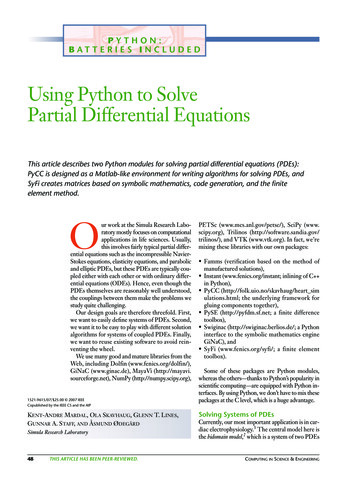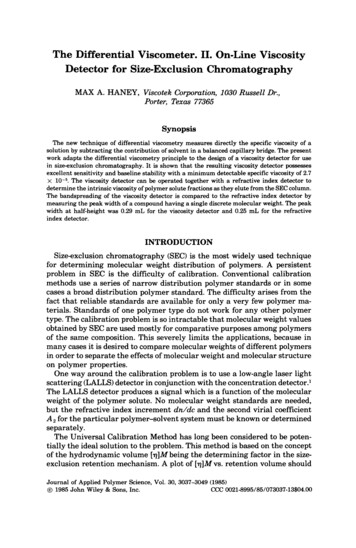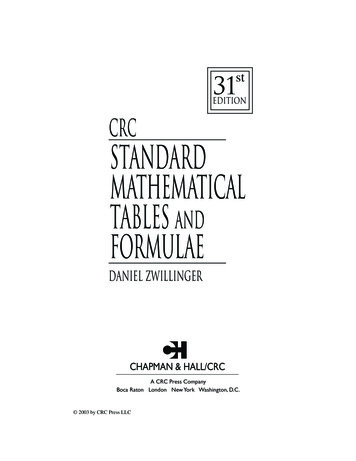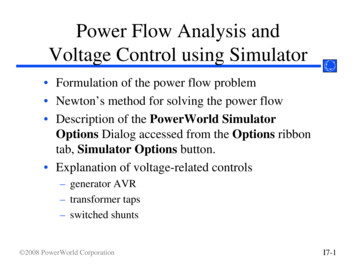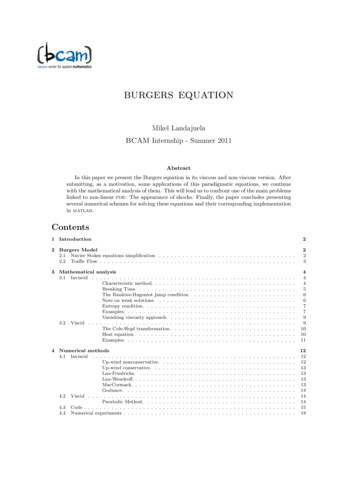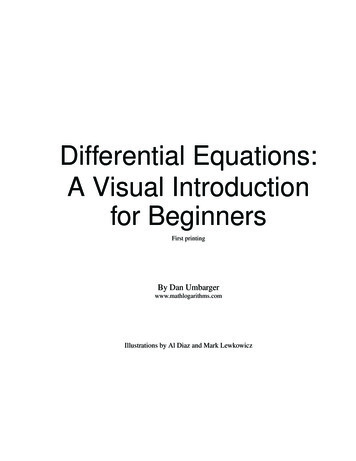
Transcription
Differential Equations:A Visual Introductionfor BeginnersFirst printingBy Dan Umbargerwww.mathlogarithms.comIllustrations by Al Diaz and Mark Lewkowicz
ContentsForeword . . . . . . . . . . . . . . . . . . . . . . . . . . . . . . . . . . . . . . . . . . . . . . . . . . . . .v0Equations and Differentials, Review of Differential Calculus . . . . . . . . . . . . . . . . . . . . . . . .11Getting Started . . . . . . . . . . . . . . . . . . . . . . . . . . . . . . . . . . . . . . . . . . . . . . . .152Using Discrete Math to Solve Growth and Decay Problems . . . . . . . . . . . . . . . . . . . . . . . . .253Using Continuous Math to Solve Growth and Decay Problems; Introduction to Separable DifferentialEquations . . . . . . . . . . . . . . . . . . . . . . . . . . . . . . . . . . . . . . . . . . . . . . . . . . .334Solving Separable Differential Equations . . . . . . . . . . . . . . . . . . . . . . . . . . . . . . . . . . .435More Applied Separable Differential Equations . . . . . . . . . . . . . . . . . . . . . . . . . . . . . . .556Solving Separable Logistic Equations . . . . . . . . . . . . . . . . . . . . . . . . . . . . . . . . . . . .677Predator–Prey: Introduction to Systems of Differential Equations . . . . . . . . . . . . . . . . . . . . . .838Solving “Linear” Differential Equations Using an Integrating Factor . . . . . . . . . . . . . . . . . . . .899Differential Equations in Physics . . . . . . . . . . . . . . . . . . . . . . . . . . . . . . . . . . . . . . . 10110 Bernoulli Equations . . . . . . . . . . . . . . . . . . . . . . . . . . . . . . . . . . . . . . . . . . . . . . 10711 Review of Partial Derivatives and Integrals: Getting Ready for Exact Differential Equations . . . . . . . . 11312 Exact Differential Equations . . . . . . . . . . . . . . . . . . . . . . . . . . . . . . . . . . . . . . . . . 12113 Homogeneous First-Order Substitution Technique . . . . . . . . . . . . . . . . . . . . . . . . . . . . . . 13914 Homogeneous Second-Order Linear O.D.E. Solution Technique with Constant Coefficients . . . . . . . . 14515 Hooke’s Law and Homogeneous Differential Equations . . . . . . . . . . . . . . . . . . . . . . . . . . . 15716 Predator–Pursuit Problems . . . . . . . . . . . . . . . . . . . . . . . . . . . . . . . . . . . . . . . . . . 16717 Review of Algebraic Systems of Equations . . . . . . . . . . . . . . . . . . . . . . . . . . . . . . . . . . 17318 Epistemology: Axioms (Postulates) vs. Theorems . . . . . . . . . . . . . . . . . . . . . . . . . . . . . . 18319 Eigenvalues, Eigenvectors, and Mat ε λ ε . . . . . . . . . . . . . . . . . . . . . . . . . . . . . . . 18520 Solving Systems of Differential Equations . . . . . . . . . . . . . . . . . . . . . . . . . . . . . . . . . . 189iii
ivDifferential Equations: A Visual Introduction for Beginners21 Phase-Plane Portraits for Two-by-Two Systems of Linear Homogeneous Differential Equations . . . . . . 20322 Background Necessary to Understand the Laplace Transform . . . . . . . . . . . . . . . . . . . . . . . . 21523 The Laplace Transform . . . . . . . . . . . . . . . . . . . . . . . . . . . . . . . . . . . . . . . . . . . . 22124 Applications of the Laplace Transform . . . . . . . . . . . . . . . . . . . . . . . . . . . . . . . . . . . . 22925 Reteaching, Reinforcing, Reviewing . . . . . . . . . . . . . . . . . . . . . . . . . . . . . . . . . . . . . 237Glossary . . . . . . . . . . . . . . . . . . . . . . . . . . . . . . . . . . . . . . . . . . . . . . . . . . . . 249A MATLAB Scripts by Chapter . . . . . . . . . . . . . . . . . . . . . . . . . . . . . . . . . . . . . . . . . 255B Converting a Logistic Differential Equation into Its Algebraic (Integrated) Equivalent . . . . . . . . . . . 285C ProofThat the Integrating Factor for a First-Order Differential Expression of the form y0 (x) P(x)y(x) IsRe P(x) dx . . . . . . . . . . . . . . . . . . . . . . . . . . . . . . . . . . . . . . . . . . . . . . . . . . . . 289D Justifying the Algebraic Technique for Solving Second-Order, Linear Homogeneous Differential Equations with Imaginary Characteristic-Equation Solutions (B2 4AC 0) . . . . . . . . . . . . . . . . . . 2912.71828 Euler’s Equation, an Introduction . . . . . . . . . . . . . . . . . . . . . . . . . . . . . . . . . . . . 293F Solving for the Integrated Solution of a Two-by-Two System of Differential Equations . . . . . . . . . . . 295G Analyzing a Generic Two-by-Two System of Ordinary Differential Equations . . . . . . . . . . . . . . . 299H Solving for the Integrated Solution of an n-by-n System of Differential Equations . . . . . . . . . . . . . 305ICalculate the Laplace Transform of sin(at) . . . . . . . . . . . . . . . . . . . . . . . . . . . . . . . . . . 309
Chapter 1Getting StartedA differential equation is an equation in one or more variables involving one or more of its own derivatives. Amajor goal of taking a class in differential equations is to solve for f (x) if given f (x), f (x), etc. That is, somehowwork backward and find the function whose derivative is given. For example, given f (x) 2x, what is f (x)?f (x) outf ′(x) inOnce we obtain the mystery f (x), we can evaluate it for any desired x. What would be the function whosedydy, is 2x? We know from differential calculus that the derivative of y x2 would be 2x. Hence, if dx 2xderivative, dx22then y x . (This can also be stated as: if f (x) 2x, then f (x) x .)But wait! A vertical shift of a44function does not impact the slopeof tangent lines! In the figure at33right, the tangent slopes to the22curves y x2 1 (green), y 1x2 2 (red), and y x2 3 (blue)1are all equal when x a, when1234 3 2 1123x 0, and when x b. There is 4 3 2 1 1 1not a single functional solution (oneFamily of solutionsunique function whose derivative is 2 2for dydx 2x2x), but a set or family of them. We 3x a 3x bwould indicate this by stating thatdy 2x the set or family of function solutions is x2 c, where c represents any constant. The vertical lines here,for dxx a, x 0, and x b are called isoclines. An isocline is notable because the slope of each function at each pointon the isocline is the same. Hence, the goal of solving a differential equation is to solve for a function or family offunctions which, when substituted into the original equation, will balance the two sides or make them equal.15
16Differential Equations: A Visual Introduction for BeginnersFrom that family of function solutions we often, using information given us, will identify the particular one thatis appropriate to our situation and use it to evaluate for specific values of x. That is called solving an initial valueproblem (IVP). In differential calculus, we studied how to obtain a derivative function from a given function. Indifferential equations, we study how to obtain a function from a given differential.In a famous French play Le Bourgeois Gentilhomme by Molière, a comicalbut buffoonish character, Monsieur Jourdain, is amazed to learn that he had beenspeaking prose all his life and didn’t even know it.“Par ma foi! Il y a plus de quarante ans que je dis de la prose sans que j’ensusse rien, et je vous suis le plus obligé du monde de m’avoir appris cela.”As Monsieur Jourdain demonstrates, it is quite possible to speak prose without knowing that you are doing it. However, it is very, very difficult to learnabstract skills and abstractions without, at some conscious or unconscious level,building upon earlier more primitive ones. Differential-equations teachers willnot tell you the information that follows because they are so smart and they haveinternalized it so deeply that they assume that you have too. To be fair to them,the university curriculum requires that they move at a very fast pace, chop-chop.Nevertheless, it is a truism that mathematicians are not always “math educators.”Be grateful if you have a teacher who can move comfortably between the twoworlds. Thank him or her.It turns out that you have been practicing many of the necessary skills to workwith and solve differential equation problems since algebra and you did not evenknow it. Making the connections shown in the following page or so of text will level the steep learning curve leadingto differential equations and perhaps give you the confidence to say, “Wow! I have been doing much of this worksince algebra and I did not even know it!”
Chapter 1Getting StartedThere are many, many coplanar lines that can be drawnwith the same linear slope. Lines that have the sameslope are said to be parallel. They do not intersect.17There are many, many quadratic equations that can bedrawn each with the same function slope. For example,dydx 2x. Coplanar curves with the same slope can besaid to be “parallel.” They do not intersect.6y x2 b5y mx b4321 3 2 1123 1 2 3Euclid’s famous fifth postulate suggests that only oneof a set of parallel lines can pass through a given point.The “Theorem of Uniqueness” says that only one ofa family of “parallel” curves can pass through a givenpoint.6y x2 b5y mx b432(2, 1)(2, 1)1 3 2 1123 1 2 3We use the above assumption to identify one of a familyof parallel lines. Find the equation of a line, y mx b,that has a slope of 2 and passes through the point (2, 1).1 1121110987654321(2, 1)m 21We use the above theorem to identify one of a family of“parallel” parabolas. Find the equation of the parabola,y x2 b, that passes through the point (2, 1). Here thed(x2 b) 2x.slope of y x2 b is 2x because dx23y 2x 3 2 4 3y mx b 1 2(2) b b 3The line passing through (2, 1) with a slope of 2 isf (x) 2x 3. 3 2 1 1y x2 3(2, 1)1234 2 3y x2 b 1 22 b b 3The parabola passing through (2, 1) with a slope of 2 isf (x) x2 3.
18Differential Equations: A Visual Introduction for BeginnersIt is possible to find the equation of the line with givenslope and passing through a given point. You could thenfind the value of y for any given x on that line: y f (x).It may be possible to find a specific function from adyfamily of solutions to dxthat passes through a specificpoint. This is called solving an initial value problem(IVP). You could then find the y for any given x on thatfunction, y x2 3.34323028262422201816141210864211109(6, ?)876y 2x 354m 2321(2, 1)123456 6 5 4 3 2 1 27(6, ?)y x2 3(2, 1)123456y 2x 3 y 2(6) 3 y 12 3 y 9y x2 3 y 62 3 y 36 3 y 33The line with slope 2 passing through (2, 1) also passesthrough (6, 9). Only one straight line does this.The parabola with slope 2x passing through (2, 1) alsopasses through (6, 33). Only one parabola does this.The complicated existence and uniqueness theorem addresses this in a real differential-equations class.Math is easier if you can make connections to previous topics! Differential equationscan be seen as a curvilinear version of work done previously with linear functions.Or, as Monsieur Jourdain would have said, “Par ma foi! Il y a plus de quarante ans que je dis de la prose sansque j’en susse rien, et je vous suis le plus obligé du monde de m’avoir appris cela.”dy 2x (or f 0 (x) 2x). For that simple equationIn Chapter 1, the differential equation we have been using was dxit was intuitive from beginning calculus that f (x) x2 . Any differential equation of any consequence will not besolved by inspection. It is good to understand that working with differential equations is kind of a reverse processdyof differential calculus. Since the differential equation ( f 0 (x) or dx 2x) was obtained by differentiating f (x), thenperhaps you can anticipate that f (x) will be obtained by integrating f 0 (x).For f (x) x2 3 the derivative f 0 (x) 2x.If it is given that the function y x2 c passes through thepoint (2, 1), thenTherefore it follows that:dygiven differential equationdx 2x1 22 cc 3Rdy 2xRdxdy 2x dxRRy0 dy 2 x1 dxmultiply by dxintegrate both sidesy x2 cy x2 3 equation of the parabola of form y x2 bintegration continuedand passing through (2, 1)integration continuedcheck:y 22simplifyWhen x 6, y x2 3 33.y x2y x2 csimplify againThere are many functionsdywith dx 2x.dyOf all the functions whose derivative is dx 2x, onlyone passes through the point (2, 1). That function also passesthrough the point (6, 33).y0 10 1x1 1 2 1 1x2d2dx (x 3) 2x!
Chapter 1Getting Started19We are used to working with functions and function notation from both algebra and calculus. We have seen bothdy. However, up to now, that notation has mostly been used to evaluate a scalar or to indicate asymbols f (x) and dxfunction. For example, for f (x) x2 , we have f (x) 2x or f (5) 10. In differential equations, it will often bedy, as an infinite set of tiny tangent segments, so tiny that each line segment is the lengthhelpful to think of f (x), dxof a point. (Points don’t have length . . . use your imagination . . . think of a computer screen pixel.) Commercialcomputer software is available to create slope fields. Because the brain has a tendency to “fill in” gaps, you can, withimagination, “see” a finite representation of that desired set of functions that results from solving the “differentialfunction.” The following is a progression of slope fields with x 1, 0.6, 0.3, and 0.1.33221100 1 1 2 2 3 3 20dydx2 2dydx 2x, x 133221100 1 1 2 2 3 3 20dydx 2x, x 0.302 2 2x, x 0.60dydx2 2x, x 0.12
20Differential Equations: A Visual Introduction for BeginnersPutting all these ideas together into one marvelous MATLAB screen we see the slope field family prescribeddy f (x) 2x. We know that there is a specific function, f (x), somewhere in theby the differential equation dxslope field family of functions whose derivative is 2x, that passes through the point (2, 1). Solving the differentialequation f (x), we get f (x) x2 c where c indicates an integration constant, a vertical shift of f (x) x2 . Usingthe information that the specific function we want passes through the point (2, 1), we solved for c by substituting the(x, y) values (2, 1) into y x2 c to find c 3. So y x2 c becomes y x2 3. Then we could find, for x 6,y 62 3 33!!60Slope field and family of solutionsfor f ′(x) 2x, f(x) x2 c. Givenf(x) passes through (2, 1), c 3.Therefore, f(x) 33 when x 6.504030(6, 33)20100(2, 1) 10 20012345678Do you remember in calculus how you learnedto successively approximate the slope of a tangentSlope field for f ′(x) 2xline by calculating the slope of approaching secantFor the particular solutionlines? (See Chapter 0.) Well a smart Swiss mathepassing through (2, 1),matician, Leonhard Euler, 1707–1783, figured out(6, ?)there is a way to find f(6)a way to successively approximate the solution towithout solving for f(x).a differential equation for a given value of x. Thegenius of Euler—who is credited with this iterady, that istive method of solving for f (x) if given dxf (x)—was that 1) he could mentally visualize thedy, that is every f (x) whoseentire slope field for dx(2, 1)derivative is f (x), and 2) he realized that he coulduse the known fact that (x, y) was on the unknownf (x) to successively approach f (z) for any z usingdy. Today, we have graphing calculators and computer softwarealgebra and trigonometry and the known f (x)—i.e., dxpackages that will help us see what Euler could visualize in the 1700s. As the slope indicators become shorter andthe tangent indicators become more numerous, each specific (particular) slope field approaches a particular solution,dy f (x) 2x and the fact that f (x) passes through the point (2, 1), wef (x). Using the information we do have, dxcan get an initial estimation of f (6) without knowing the function f (x).In the figure above, we have a point (2, 1) and we know the slope of the unknown function at x 2 is 4. That is,f (2) 2 2 4. We wish to find the unknown point (6, ?) on the unknown function f (x). With the two given xvalues (2 & 6), we can determine x 6 2 4. If we could determine y, we could calculate y y and obtain
Chapter 1Getting Startedthe new y value. How can we determine the y value? We know from studying trigonometry that tan θ opp (tan θ) adj. We know from studying algebra that m 1. The slope m yx rise yrun x .opp yadj x21henceSo, tan θ m.Slope moppadj .opp2. opp m adjadjSubstituting into opp m adj y m x y 2x 4 . . . m at point (2, 1) is 2x y 4 4 16 . . . m at point (2, 1) 4New y old y y. y 1 16 17. We estimate that f (6) for the unknown function, f (x), might be 17. Basicallywe have “extended” out (extrapolated) the tangent line until it reached an x value of 6.19181716151413121110987654321 x 4xy2.01.06.0 17.0(6, 17)6 2 x17 1 ydydx m 2xm oppadj y 16 y x y m x 2x 4 2 2 4 16(2, 1)123 x 44 56789 10 11 12 13 14 15Recall from differential calculus (reviewed in Chapter 0) how we improved our secant slope estimate of a tangentslope in the example by decreasing x:x (domain)y 0164y2 y1x2 x1m 64 08 0 8m 64 168 4 1264 36m 8 6 14m 64 498 7 1564 62.41m 8 7.9 15.9m 64 63.8401 15.998 7.99m 64 63.984001 15.9998 7.99964 640m 8 8 0 16?m Indeterminate division by zero
22Differential Equations: A Visual Introduction for BeginnersThat same “successive approximation” technique can be used in differential equations to improve our estimationdyof f (6). That is, given f 0 (x) dx 2x and the fact that the function we seek passes through point (2, 1), we canimprove our original estimation of the unknown f (x) at 6— f (6) 17—by reducing the x we used to project outfrom (2, 1).For the example above, change from x 4 to x 1. x 1,N12345 y 2xn xxn xn 1 xx1 2 (given)x2 2 1 3x3 3 1 4x4 4 1 5x5 5 1 6By decreasing x, we get values closer and closer to the actualf (6). The text box at right and thefive text boxes below were generated by the computer programshown on the following page.dybecause 2x, so dy 2x dxdx y 2 xn 1 xNot applicable2 2 1 42 3 1 62 4 1 82 5 1 10 x 1xy2.01.03.05.04.0 11.05.0 19.06.0 29.0yn yn 1 yy1 1 (given)y2 1 4 5y3 5 6 11y4 11 8 19y5 19 10 7654321 x 1xy2.01.03.05.04.0 11.05.0 19.06.0 29.0Compare (6, 32.996) for x 0.001,with the exact solution (6, 33) we gotseveral pages back. Fortunately, theseanswers are close. Otherwise, therewould be egg on the author’s face! x 1.4232.66(xn ,yn)(2, 1)(3, 5)(4, 11)(5, 19)(6, 29)(6, 29)m 10(5, 19)m 8(4, 11)m 6m 4dydx(3, 5) m 2x(2, 1)1 x 4xy2.01.06.0 17.0!23 x 96.0032.6032.7232.8432.96456789 x 9610
Chapter 1Getting Started23public class EulersMethodSolvingAnODE{public static void main(String args[]){double x 2;double y 1;double deltaX 1; // x is run for 4, 1, 0.1, 0.01, and 0.001System.out.println("x y"); // column headerswhile (x 6){System.out.println(x ", " y);// tan theta opp/adj, so opp tan theta * adj. Ergo y n y n - 1 dy/dx * xy y (2 * x) * deltaX; // new y old y length side opposite thetax x deltaX; // new x old x deltaX} // end while} // end main} // end JavaTemplateThere are software packages available that allow you to experiment with the ideas taught in adifferential equations class. A jar file can be purchased from Cengage Publishers. One of the options allows the user to experiment with Euler’smethod for different differential equations.Below, passing through (0.24, 1.2), you seeEuler’s method for x 1, 0.5, 0.25, 0.125, andthe Runge–Kutta 4 algorithm applied to the differ2ential equation dydt y 4t.For people with a programming background it is not too much of a stretch to understand where the slope fieldsand the graphs of a particular function come from. Code based on Euler’s method (or perhaps another iterativedyalgorithm called the Runge–Kutta method) is used on the given differential equation, dxor f 0 (x), to generate a set
24Differential Equations: A Visual Introduction for Beginners4of ordered pairs of points which, x 0.001as closely as desired, approxi3xymate points lying on the un2.0001.0002known function, f (x). Then, us2.0011.004ing the slope information immedi2y t12.0021.008ately available from the differen2.0031.012dy0tial equation ( dx m, right?) to2.0041.016gether with any desired delta value 1.and simple trig function knowl 25.995 32.936edge such as shown above in Eu5.996 32.948ler’s method, one could write code 35.997 32.960to identify end points of a tangent 45.998 32.972segmenttotheunknownf(x).The 4 2024code to draw straight-line segments between two points is well known and precoded in5.999 32.984many languages (e.g., g.drawLine in Java). Voilà! There you have a tangent segment6.000 32.996drawn to a point that is on, or very, very close to being on the unknown function curve. Ifyou bring your delta close to zero, then the tangent-line slope segment approaches length “zero” which in “computerese” means one pixel. Then your graph would be a very close visualization of the unknown solution function itself.That function (shown above) can be thought of as a particular example of the family of solutions differentiated fromthe others by the fact that each of its tangent-slope segments are of length “one pixel.” Look at the figure and rereadthis paragraph if it was not clear at first.Chapter 1 ReviewChapter 1 starts out defining a differential equation as an equation in one or more variables involving one or moreof its own derivatives. A major goal of taking a class in differential equations is to solve for f (x) if given f (x),f (x), etc. That is, somehow work backward and find the function whose derivative is given. That paradigm is justthe opposite of differential calculus when you are given a function and asked to find its derivative.Side-by-side examples of coplanar parallel linear lines and coplanar “parallel” parabolas were given. It wasshown that, if given a point on a straight line as well as its slope, you could find the y value of a different pointon that line if given its x value. Similarly, it is the case for the parabolas. The concepts slope field and particularsolution were introduced as well as Euler’s iterative technique for approximating an unknown point on an unknownfunction whose derivative and initial value are known.Online ApplicationVisit erentialEquations for a great little applicationthat will demonstrate some of the concepts from thischapter. “Numerical Methods for Differential Equations” from the Wolfram Demonstrations Project. Contributed by Edda Eich-Soellner.
Chapter 4Solving Separable Differential EquationsIn Chapter 3, we studied differential equations that, through algebraic techniques, could be rewritten in such away that the numerator differential and its respective variable were together on one side of the equation and thedenominator differential and its respective variable were together on the other side. Then, both sides were integrated.Continuous Compounding of Interestdp r pdt1dp r dtpZZ1dp r dtpetc.Carbon 14 DecaydC r Cdt1dC r dtZ CZ1dC r dtCetc.Continuous Population GrowthdP r Pdt1dP r dtZ PZ1dP r dtPetc.Differential equations in which this technique can be used are called “separable differential equations.” They arethe easiest type of differential equations to work with. Moving from general to specific,dy f (x) g(y), g(y) , 0dxstandard form for a separable differential equation1dy f (x) dxg(y)ZZ1dy f (x) dxg(y)etc.,we get the following examples.Ex 1dy 3dxdy 0 0 3x 1ydxSeparable!Ex 2rdyx dxyqdy x y 1dxdy 1 1 x2 y 2dxSeparable!Ex 5dy 3x2 4x 2 dx2(y 1)# "1dy2 1 3x 4x 2 (y 1)dx2Separable!Ex 3dy x2 1dx dy 2 x 1 1y0dxSeparable!Ex 6dy y2 1 dxx 1 dy (x 1) 1 y2 1dxSeparable!43Ex 4dyx2 dx 1 y2 1dy 2 x 1 y2dxSeparable!Ex 7dyy cos x dx 1 2y2dyy (cos x) dx1 2y2Separable!
44Differential Equations: A Visual Introduction for BeginnersThe point that is being made here is that if a differential equation can be put into the formdy f (x) g(y), g(y) , 0,dxthen it can be solved by the “separable technique” as shown above. As a general rule, it is easier to immediately strivefor separation of the variables and differentials from the beginning rather than to put the equation into the genericform shown here and then to separate. The example above is just to create an understanding of how to categorizedifferential equations.Your differential-equations teacher sometimes has a perspective, an understanding and a schema that give anintangible advantage over you when looking at problems. Here is an example.6“Solving a separable differential equation is the reverseof implicit differentiation.”5So, what is a new skill to the student is just a backwardversion of what the differential equation teacher taughtback in differential calculus. They blend seamlessly in theteacher’s mind.If you understood that last sentence go ahead and skipover this next part. Otherwise let’s go back to differential calculus and review explicit and implicit differentiation and then revisit this idea. Find the slope of the tangent to the circle x2 y2 25 at the point when x 4.By substitution, then, 42 y2 25 and y 3. Using ideastaught in beginning calculus, then, the slope of the tangentwould be equal to the derivative of the function evaluatedat (4, 3).34(4, 3)21 6 5 4 3 2 1 1 2 3 4 5 6123456
Chapter 4Explicit Differentiationx2 y2 25 (25 is r2 )y2 25 x2 1y 25 x2 2 *** 1dy1 25 x2 2 ( 2x)dx2 x 1 25 x2 2 x 25 x2 x (from *** above)ySolving Separable Differential EquationsImplicit Differentiationx2 y2 25 d 2dx y2 (25)dxdxdy2x 2y 0dxdy2y 2xdxdy x dxyHere, the derivative is in terms ofboth x and y.45Reverse Implicit Differentiationdy x dxyy dy x dxZZy dy x dxy2x2 c1 c222x 2 y2 C22x2 y2 K 2For x 4 and y 3, K 5.x2 y2 25“Solving a separable differential equation is the reverse of implicitdifferentiation.”Understanding connections makes mathematics more interesting. It alsolets you see that new ideas are often connected to or related to old ones.dy f (x) g(y), g(y) , 0dx1dy f (x) dxg(y)ZZ1dy f (x) dxg(y)We’ll spend the rest of this chapter reviewing those slope fields. Since this is otherwise a short chapter andslope fields will be used extensively in the next chapter, it might be good to talk more about them again. Slopefields are useful in anticipating solutions to differential equations and are a necessity when trying to get informationabout unsolvable differential equations. Today’s software graphing packages really do all the work for you. However,like many topics in math, they obscure what really goes on. Just like everything else in postcalculator mathematicseducation, those graphing packages have potential for harm. For example, in my first book, Explaining Logarithms,I posited the scenario of a student claiming that 234 4,192 8,219 or y log4.8 714.6, y 22.9 because “thecalculator said so.”
46Differential Equations: A Visual Introduction for BeginnersAll high school math teachers have heard statements such as these. As another example, when I was in college,the education majors would take 12 -inch thick SAS or SPSS printouts offm undefinedthe printer and proceed to make incredible conclusions based on theirm 2.41m 2.41“data.” When asked what a correlation or standard deviation was,m 1m 1they didn’t know and they did not care that they didn’t know.It is best for most people to see how slope fields ariseby doing a few of them the old fashioned way. We’ll m 0.41m 0.41start with a quick review from trig regarding selectedslope values before proceeding. The following valuesare obtained by taking the tangents of 180, 157.5,m 0m 0135, 112.5, 90, 67.5, 45, 22.5, and 0 degrees.The following shows three different examples of slope fields being graphed “by hand” (without a computer).1. Graph the slope field fordydx4 yx3Step 1: Red slope segments for x 0.dydx(x, y) yx(m)2Slope color1(0, 3)0red(0, 2)0red(0, 1)0red 1(0, 0)indetred 2(0, 1)0red0red 3(0, 3)0red(0, 2)0 4 4 2024Step 2: Green slope segments for x 1.dydx(x, y)(1, 3)(1, 2) yx(m)Slope color 13 12greengreen4green3(1, 0) 1undefgreen(1, 1)1green21213green1green0(1, 1)(1, 2)(1, 3)Step 3: Blue slope segments for x 1.dydx(x, y) yx(m)Slope colorblue( 1, 2)1312( 1, 1)1blue( 1, 0)undefblue( 1, 1) 1blue( 1, 3)( 1, 2)( 1, 3) 12 13blueblueblue 1 2 3 4 4 2024
Chapter 4Solving Separable Differential Equations47Step 4: Brown slope segments for x 2.dydx(x, y)(2, 3) yx(m)Slope color 23brown 24 1brownbrown3(2, 0)undefbrown(2, 1)2brown21brown1(2, 3)23brown0(2, 2)(2, 1)(2, 2)Step 5: Orange slope segments for x 2.dydx(x, y) yx(m)Slope color( 2, 3)23orange( 2, 2)1orange( 2, 1)2orange( 2, 0)undeforange( 2, 1) 2orange( 2, 3) 23orange( 2, 2) 1 1 2 3 4 4 202orangeStep 6: Purple slope segments for x 3.dydx(x, y)4(3, 3)3(3, 1)2 yx(m) 1purple 3purplepurple(3, 0)undefpurple(3, 1)3purple32purple(3, 3)1purple(3, 2)0Slope color 23(3, 2)1Step 7: Black slope segments for x 3. 1dydx(x, y) 2 3 4 44 2024 yx(m)Slope color( 3, 3)1black( 3, 2)32black( 3, 1)3black( 3, 0)undefblack( 3, 1) 3black 1black( 3, 2)( 3, 3) 32blackWhat you need to do is to try to imagine many, many slope indicators each with diminished length until theyreach the length of a point (po
Math is easier if you can make connections to previous topics! Di erential equations can be seen as a curvilinear version of work done previously with linear functions. Or, as Monsieur Jourdain would have said, “Par ma foi
